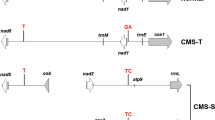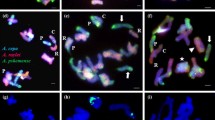Summary
Mitochondrial and chloroplast DNA was isolated from fertile and cytoplasmic male sterile cultivars of cultivated onions. Restriction fragment length polymorphism led to the distinction between cytoplasms S and M. Mitochondrial DNA patterns from S cytoplasms appeared dentical and characterized mostly male sterile lines. An open-pollinated variety was found to bear this cytoplasm and thought to be the origin of S types. Mitochondrial DNA patterns from M cytoplasms were subdivided into four types, M1 and M2 corresponding to normal N cytoplasm, M3 and M4 probably corresponding to T cytoplasms. S and M cytoplasms were also distinguished by chloroplast DNA restriction patterns. Our results confirm previous genetic distinction between S, N and T cytoplasms.
Similar content being viewed by others
References
Berninger E (1965) Contribution à l'étude de la stérilité mâle de l'oignon (Allium cepa L.) Ann Amél Plant 15:183–199
Bookjans G, Stummann BM, Henningsen KW (1984) Preparation of chloroplast DNA from pea plastids isolated in a medium of high ionic strength. Anal Biochem 141:244–247
Boutry M, Faber AM, Charbonnier M, Briquet M (1984) Microanalysis of plant mitochondrial protein synthesis products. Plant Mol Biol 3:445–452
Clayton EE (1950) Male sterile tobacco. J Hered 41:171–175
Dewey RE, Levings CS, Timothy DH (1986) Novel recombinations in the maize mitochondrial genome produce a unique transcriptional unit in the Texas male-sterile cytoplasm Cell 44:439–449
Dewey RE, Timothy DH, Levings CS (1987) A mitochondrial protein associated with cytoplasmic male sterility in the T cytoplasm of maizc. Proc Natl Acad Sci USA 84:5374–5378
Forde BG, Leaver CJ (1980) Nuclear and cytoplasmic genes controlling synthesis of variant mitochondrial polypeptides in male-sterile maize. Proc Natl Acad Sci USA 77:418–422
Hanson MR, Conde MF (1985) Functioning and variation of cytoplasmic genomes: Lessons from cytoplasmic-nuclear interactions affecting male fertility in plants. Int Rev Cytol 94:213–267
Holford F, Newbury HJ, Croft JH (1988) Differences in the mitochondrial DNA of male-fertile, cms S and cms T onions. Proc 4th Eucarpia Allium Symp, pp 205–211
Jones HA, Clarke AE (1943) Inheritance of male sterility in the onion and the production of hybrid seed. Proc Am Soc Hortic Sci 43:189–194
Jones HA, Mann LK (1963) Onions and their allies. Botany, cultivation and utilization. Interscience, New York, 286 pp
Leaver CJ, Gray MW (1982) Mitochondrial genome organization and expression in higher plants. Ann Rev Plant Physiol 33:373–402
Leaver CJ, Isaac PG, Bailey-Serres J, Small ID, Hanson DK, Fox TD (1985) Recombination events associated with the cytochrome c oxydase subunit I gene in fertile and cytoplasmic male sterile maize and sorghum. In: Quagliarello E, Slater EC, Palmieri F, Saccone C, Kroon AM (eds) Achievements and perspectives of mitochondrial research, vol 2. Elsevier, Amsterdam New York Oxford, pp 111–122
Levings CS (1983) The plant mitochondrial genome and its mutants. Cell 32:659–661
Li XQ, Chétrit P, Mathieu C, Vedel F, De Paepe R, Remy R, Ambard-Breteville F (1988) Regeneration of cytoplasmic male sterile protoclones of Nicotiana sylvestris with mitochondrial variations. Curr Genet 13:261–266
McCollum GD (1976) Onions and allies. In: Simmonds NW (ed) Evolution of crop plants. Longman, London New York, pp 186–190
Pring DR, Lonsdale DM (1985) Molecular biology of higher plant mitochondrial DNA. Int Rev Cytol 97:1–46
Quétier F, Vedel F (1977) Heterogeneous population of mitochondrial DNA molecules in higher plants. Nature 268:365–368
Rabinowitch HD (1988) Genetics and breeding: state of the art or too slow but not too late. Proc 4th Eucarpia Allium Symp, pp 57–69
Schweisguth B (1973) Etude d'un nouveau type de stérilité mâle chez l'oignon, Allium cepa L. Ann Amél Plant 23:221–233
Vedel F, Mathieu C (1982) Isolation of purified mitochondrial DNA from Brassicae. Anal Biochem 127:1–8
Vedel F, Quétier F, Bayen M (1976) Specific cleavage of chloroplast DNA from higher plants by Eco RI restriction nuclease. Nature 263:440–442
Young EG, Hanson MR (1987) A fused mitochondrial gene associated with cytoplasmic male sterility is developmentally regulated. Cell 50:41–49
Author information
Authors and Affiliations
Additional information
Communicated by H. F. Linskens
Rights and permissions
About this article
Cite this article
de Courcel, A.G.L., Vedel, F. & Boussac, J.M. DNA polymorphism in Allium cepa cytoplasms and its implications concerning the origin of onions. Theoret. Appl. Genetics 77, 793–798 (1989). https://doi.org/10.1007/BF00268328
Received:
Accepted:
Issue Date:
DOI: https://doi.org/10.1007/BF00268328




